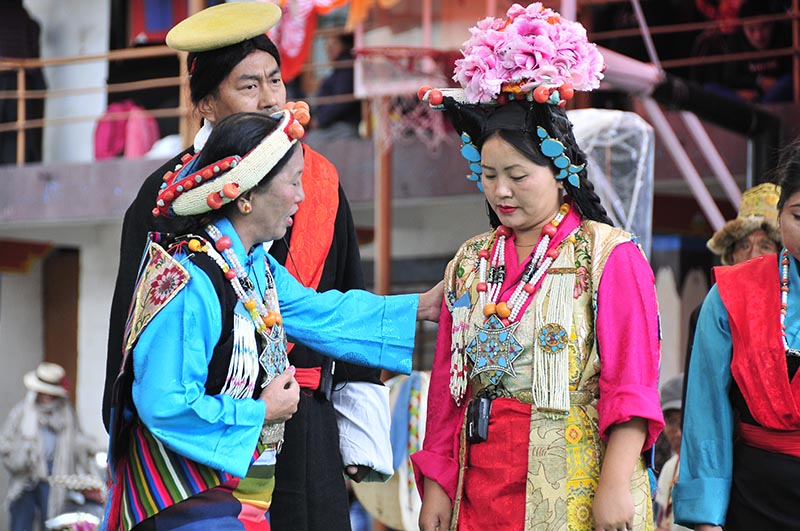This is an indigenous Tibetan story based on events that occurred around the eleventh century near the town of Gyangtsé, west of Lhasa. Nangsa was a beautiful young woman who wanted to devote herself to the Dharma, but her beauty attracted the attention of the local governor who was seeking a bride for his son. Her parents were in no position to resist the authority of the governor and Nangsa was taken away to become a bride. After seven years she gave birth to a son. One day while she was working with others in the fields two cotton-clad yogis appeared asking for alms. Filled with devotion, Nangsa gave some of the harvests to them. Her husband’s sister, who witnessed this, flew into a rage and beat Nangsa, but then ran to her brother saying that Nangsa had beat her. Nangsa’s husband believed his sister and he too beat his wife. Later a lama, who had manifested as a beggar and his dancing monkey, arrived at the house. Nangsa wanted to give them something and brought them secretly into the house.
NANGSA OBUM

This was discovered by her husband, who beat her again and took away her little son. The pain and grief were too much for Nangsa and that night she died. Filled with remorse, her husband placed her body on the mountain top. There her consciousness wandered off into the intermediate state, where she came into the presence of the Lord of Death. He saw that Nangsa was no ordinary woman and told her that she should return to her life and do good in the world.
Nangsa returns to life and, entreated by her repentant family and her son, takes up her place again in the family. She teaches the Dharma and involves herself in worldly life. Yet she becomes discouraged by the lack of response to her teachings and by having no time to devote herself to the Dharma. Seeing her sadness, her husband sends her to her parents, hoping to wean her away from the religious life.
Back with her parents, she still yearns for the religious life, much to their annoyance. After one particular incident when Nangsa starts weaving in the courtyard and singing beautiful allegorical songs using the parts of the loom as metaphors for the Dharma, her mother becomes enraged and throws her out of the house. That evening she leaves the house and finally arrives at the monastery of the lama who had previously manifested as the beggar and the monkey. After a series of tests, she is taken in by the lama to become his disciple, and after a few months of meditation, she gained realizations.
Sometime later her husband and his army arrive at the monastery to take her back. They attack and scatter the monks. Fearful that her lama would kill, Nangsa rises into the air and shows her powerful supernatural form. Her husband and his army are cowed. They repent their ways, her son takes over the kingdom, and Nangsa is free to continue her spiritual journey.
This story is considered to be based on actual events, and the text of this volume mentions that while Nangsa was at the monastery she meditated in a cave and that imprints of her cloak and can still be seen on its walls “like impressions made in butter.” Nangsa is often cited as an example of the phenomenon of a death returner (’das log), one who returns to life after death. Many accounts of death-returners are to be found in Tibetan literature, but Nangsa is the only one to have been made into an Opera.








